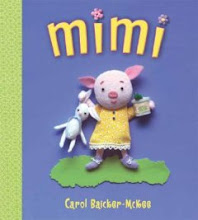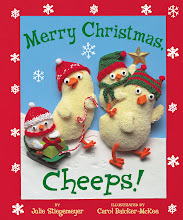
Copyright 2009, Carol Baicker-McKee
Cost of One Piece Original Art by Carol Baicker-McKee from An Apple Pie for Dinner by Susan vanHecke (Marshall Cavendish, Fall, 2009)
Testing for:
Foamcore for backing and supports $100
Mat board for support $100
Chenille stems (metal plus fabric) $200
3 colors of acrylic paint $300
13 colors of polymer clay $1300
12 different fabrics $1200
5 different threads and floss $500
4 different textile trims $400
Polyester batting $100
Metallic powder $100
2 colors pastels $200
Labor, artistry $500
Total: $5,000
Cost of destroying my one of a kind artwork so I can sell it: Priceless
My mixed media artwork is undeniably more complex, with many more components than most illustrators' work (the above photo is of a much simpler book in progress, and you can see there are lots of parts), but non-artists would still be shocked to break down the components in even a typical painting. Plus the parts of a frame. But either way, illustrators who want to sell their artwork on the open market, especially if like me they haven't yet achieved the level of fame and fortune that would allow their work to be classified as "collectible" (and thus not intended for use in a children's bedroom) are probably in deep doo-doo under CPSIA. My estimate above of the testing costs is surely a low ball figure, as I used only $100 per component and I know that's low, and I've undoubtedly overlooked a few pieces to boot. Unframed, testing costs would drive up the price to 10 times what I'd guess would be a top, top make-me-very happy price for that piece. Framing would add a couple hundred dollars more. And then there's the wee final problem: I'd have nothing left to sell after I got it tested.
When I spoke with Joe Martyak, the Chief of Staff at CPSC, for information for my article for the Society of Children's Book Writers and Illustrators (SCBWI), he initially seemed bewildered about my questions about original artwork and CPSIA; he didn't seem to think wall artwork was covered. When I said I'd read several documents from CPSC that specifically mentioned posters and other wall decor, he hemmed and hawed, and said, well, if it was intended for a child's room, it probably would be. Then he said art wouldn't be considered accessible once it was framed. I said, "How is art protected by a piece of fragile glass on one side and a thin piece of cardboard on the other less accessible than the inside of a bike tire valve stem? And how does an artist judge what is "normal use and abuse" for a framed picture? Because if it includes throwing something that knocks it off the wall, it could certainly become accessible, though of course the broken glass might be a more immediate worry." I also asked about the problem of testing one of a kind items (known among the crafty set as OOAK items). At that point, he decided he'd have to get back to me about original art.
Of course he hasn't yet, and I don't blame him; among the millions of details the CPSC has to sort through and rule on, questions about original art surely rank very low - unless you're an artist creating work that would be bought for kids and you'd like to keep earning a living. (Or in my case, would also like to clear a little shelf space to accommodate all the other bulky art work you're producing.)

This piece is a very simple one, one of several I made at my publisher's request as promotional giveaways to promote one of my books (Merry Christmas, Cheeps! by Julie Stiegemeyer, Bloomsbury, 2007). Paying to test it would of course be foolish on many fronts, but even a small simple piece like this has an insane number of components (at least 22 by my quick count), thus putting an end to cool promotional items. These matter because buyers for book chains base their orders on initial buzz for the book at BEA and other venues - and special promotional tactics get attention.
 The photos above and below are of a piece I made for a charity, Robert's Snow, that raises funds for cancer research. The event honors the husband of the enormously talented and well-loved children's book author and illustrator Grace Lin, who was stricken with a rare cancer. Children's book illustrators are invited to create artwork on wooden snowflakes which are then auctioned. Again, mine is probably more complex than most, but many others are incredible 3-D creations too. (And little did I realize by adding a box intended for long term storage I'd be adding to the components in need of testing.) Some of the snowflakes by top illustrators fetch collectible level prices, but others are not out of question for hanging in a child's room. It's yet another very gray area under CPSIA, surely not one that anyone intended, but one that looms ominously over people trying to do a good thing nonetheless.
The photos above and below are of a piece I made for a charity, Robert's Snow, that raises funds for cancer research. The event honors the husband of the enormously talented and well-loved children's book author and illustrator Grace Lin, who was stricken with a rare cancer. Children's book illustrators are invited to create artwork on wooden snowflakes which are then auctioned. Again, mine is probably more complex than most, but many others are incredible 3-D creations too. (And little did I realize by adding a box intended for long term storage I'd be adding to the components in need of testing.) Some of the snowflakes by top illustrators fetch collectible level prices, but others are not out of question for hanging in a child's room. It's yet another very gray area under CPSIA, surely not one that anyone intended, but one that looms ominously over people trying to do a good thing nonetheless.If you have a few more minutes, go check out this post at Deputy Headmistress's The Common Room. She finally found someone to kind of debate the merits (or at least intentions) of CPSIA with her. PJFry via BoingBoing mentions a number of the misconceptions about lead in books, and Deputy Headmistress walks her through the science and real-life reasons why they're wrong.






















No comments:
Post a Comment